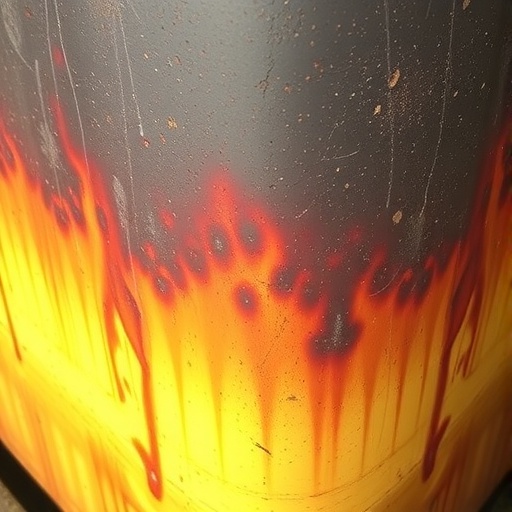Recent studies have illuminated the corrosion characteristics of low-carbon cast steel, specifically ZG230-450, when exposed to an atmospheric environment dominated by chloride-sulfate conditions. As the world pushes toward more advanced materials capable of withstanding harsh environmental factors, understanding the degradation processes of existing materials has never been more crucial. The research conducted by Zheng et al. highlights how these conditions can significantly impact the longevity and performance of low-carbon cast steel in various applications, including construction and heavy machinery.
In the context of infrastructure, where metals are frequently exposed to corrosive materials, identifying the specific variables that influence corrosion rates in steel is essential. Low-carbon cast steel, known for its malleability and toughness, is widely used in these applications. However, the adverse effects of harsh environments, particularly those rich in chloride and sulfate, can lead to accelerated corrosion. In this study, the specific corrosion characteristics of ZG230-450 were analyzed in a detailed examination, revealing the mechanisms behind its deterioration over time.
The study employed rigorous experimental methods to simulate the chloride-sulfate atmospheric environment. By replicating conditions that are typically found in coastal areas or regions with high moisture and pollutants, researchers aimed to gather a comprehensive understanding of how these factors influence corrosion rates in low-carbon cast steel. The results underscore the role of environmental chemistry in attacking the surface of metals, leading to both pitting and general corrosion, critical issues that can compromise the structural integrity of structures that rely on such materials.
Moreover, the techniques used for analyzing corrosion were sophisticated and illustrative. The research team utilized electrochemical measurements to determine the corrosion potential and current density, which are vital indicators of a material’s susceptibility to corrosion. These measurements were complemented by surface analysis techniques, including scanning electron microscopy, allowing for a visual confirmation of corrosion progression and surface degradation.
The findings suggest that the vulnerability of ZG230-450 increases with exposure duration to corrosive environments. Over time, the chlorides permeate the protective oxide layer on the steel surface, leading to localized corrosion such as pitting. This particular mode of corrosion is alarming as it can remain undetected until significant damage has occurred, making it a silent threat to structural safety. The implications of these findings are substantial, not only for engineers and architects but also for stakeholders in industries relying on these materials.
To further elucidate this phenomenon, the study delved into the electrochemical mechanisms driving corrosion in saline environments. The researchers noted that the presence of sulfate ions exacerbates the corrosive action of chlorides, leading to synergistic effects that accelerate material degradation beyond what would be expected from either ion alone. This emphasis on the interplay between different corrosive agents represents a pivotal insight for future material selection and engineering approaches.
Additionally, the authors highlighted the importance of protective coatings and surface treatments in mitigating these corrosive effects. Implementing advanced coatings could be a significant step toward enhancing the durability of low-carbon cast steel in aggressive environments. Techniques such as galvanization or the application of corrosion inhibitors are being explored to prolong the service life of ZG230-450 and similar materials.
With the ongoing challenges posed by climate change and increasing pollution levels, understanding how environmental factors influence corrosion becomes increasingly urgent. The study’s results spur discussions surrounding the necessity for improved specifications in material usage across various sectors. This could potentially inform future regulations or best practices concerning construction materials in susceptible environments.
Being cognizant of these factors not only aids in extending the lifespan of steel but also promotes sustainability by reducing the frequency of repairs and replacements. Notably, the economic implications of prolonged material life can influence project budgets significantly, which is particularly beneficial in infrastructure projects requiring substantial resources.
The research performed by Zheng et al. not only lays the groundwork for future studies on low-carbon cast steel but also serves as a clarion call to prioritize corrosion research within the materials science community. As industrial demands evolve, further investigations into material performance in challenging environments will be essential not only for enhancing current materials but also for driving innovations in new, corrosion-resistant technologies.
As industries move forward, it becomes increasingly critical for engineers, manufacturers, and policymakers to incorporate these findings into design and maintenance strategies. By recognizing the factors that contribute to corrosion, stakeholders can better anticipate challenges and craft solutions that emphasize both safety and sustainability in material selection.
In conclusion, the investigation into the corrosion characteristics of low-carbon cast steel in chloride-sulfate environments reveals essential insights that have far-reaching implications for the safety, durability, and economic efficiency of structures worldwide. Ongoing research in this arena will be vital as we strive to understand and combat the effects of our changing environments.
Subject of Research: Corrosion characteristics of low-carbon cast steel ZG230-450 in chloride-sulfate atmospheric environment
Article Title: Corrosion characteristics of low-carbon cast steel ZG230-450 in chloride-sulfate atmospheric environment
Article References:
Zheng, X., Zhao, Y., Yang, H. et al. Corrosion characteristics of low-carbon cast steel ZG230-450 in chloride-sulfate atmospheric environment. Environ Sci Pollut Res (2025). https://doi.org/10.1007/s11356-025-36847-w
Image Credits: AI Generated
DOI: 10.1007/s11356-025-36847-w
Keywords: Corrosion, low-carbon cast steel, ZG230-450, chloride-sulfate environment, corrosion mechanisms, protective coatings.




